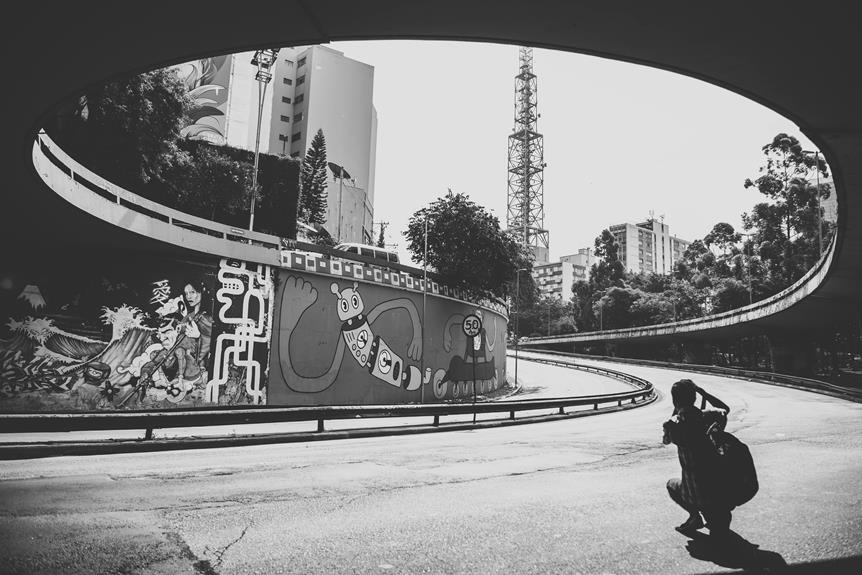Spiritual Art
Spiritual art, intertwined with humanity’s ancient past, portrays religious beliefs, celestial bodies, and mystical experiences. Through masterpieces like ‘The Creation of Adam‘ and ‘The Last Supper‘, art connects viewers to profound spiritual truths. Symbolism and themes in spiritual art span divine figures, significant events, and healing scenes, enriching the human quest for meaning. Techniques such as sacred geometry and vibrant colors enhance this transcendence. Influential artists like Mark Rothko and Alex Grey explore deep spiritual responses through various mediums. Modern spiritual art blends traditional symbols with contemporary styles, reflecting evolving spiritual and cultural concerns. Discover how these elements weave together.
Key Points
- Spiritual art uses divine figures, celestial bodies, and symbolic imagery to convey deep spiritual truths and narratives.
- Techniques like sacred geometry and vibrant colors enhance the transcendental experience in spiritual artworks.
- Influential artists like Hilma af Klint and Alex Grey explore spirituality through abstract and visionary art.
- Modern spiritual art blends traditional symbols with contemporary styles, covering themes like mindfulness and environmental consciousness.
- Mediums range from acrylics and oils to digital art, offering diverse expressions of spirituality.
Historical Significance
Spiritual art’s historical significance is profound, as it has been an integral part of human expression and cultural development since ancient civilizations like the Egyptians and Greeks. By depicting religious beliefs, celestial bodies, and mystical experiences, spiritual art has served as an essential conduit for conveying complex spiritual ideas.
Iconic pieces like Michelangelo’s ‘The Creation of Adam’ and da Vinci’s ‘The Last Supper’ illustrate this tradition, representing pivotal moments in spiritual history. Through movements such as the Renaissance and Baroque periods, spiritual art evolved, producing masterpieces that are still celebrated.
These artworks don’t just depict faith; they connect viewers to deeper spiritual truths, revealing the timeless relevance and transformative power of spiritual themes in art.
Symbolism and Themes
While the historical significance of spiritual art is undeniable, the rich symbolism and recurring themes within these works provide profound insights into the collective human quest for meaning and transcendence.
You’ll find that divine imagery often inspires awe and faith, with spiritual art exploring various themes that represent a greater force in the world. Iconic pieces such as frescoes of The Last Supper or depictions of Buddha carry deep symbolic weight.
- Divine Figures: Representations of Jesus, Buddha, and angels are prevalent, embodying spiritual ideals.
- Significant Events: Themes like the birth of Jesus and the second coming convey powerful spiritual narratives.
- Symbolic Imagery: Elements like shepherds or the concept of loving your neighbor enrich the visual storytelling.
- Healing and Redemption: Scenes like the healing of Tobit highlight themes of spiritual restoration.
Techniques and Mediums
In exploring the techniques and mediums of spiritual art, you’ll find that artists skillfully employ a variety of methods and materials to evoke a sense of the divine and transcendental. Techniques such as symbolism, sacred geometry, and intricate patterns are commonly used to convey spiritual themes. Artists often choose vibrant colors and detailed designs to enhance the sense of transcendence in their work.
Mediums vary widely, including acrylics, oils, mixed media, and digital art. Mandala drawing, chakra alignment, and nature symbolism are frequent techniques, creating a connection to spiritual concepts. The choice of canvas, paper, wood, or digital platforms allows artists to express their spiritual visions in diverse and impactful ways, offering viewers a profound and immersive experience.
Influential Artists
Several artists have profoundly shaped the landscape of spiritual art, each bringing unique perspectives and techniques that invite deeper contemplation and connection.
- Hilma af Klint: Her abstract spiritual paintings predate the Abstract Expressionist movement, emphasizing spiritualism and mysticism.
- Mark Rothko: Known for his large, contemplative color field paintings, he sought to evoke deep emotional and spiritual responses.
- Alex Grey: His intricate and visionary art explores spirituality and consciousness, often delving into transcendental experiences.
- William Blake: A poet and painter, Blake’s mystical and symbolic artworks are infused with profound spiritual themes.
Each artist’s contributions have enriched spiritual art, making it a dynamic and evolving field that continues to inspire and challenge perceptions.
Modern Interpretations
Blending traditional symbols with contemporary styles and techniques, modern interpretations of spiritual art capture the evolving nature of contemporary spirituality and its multifaceted expressions.
You’re likely to see artists using digital art, mixed media, and experimental techniques to create works that resonate on multiple levels.
Themes often cover mindfulness, inner peace, environmental consciousness, and social justice, reflecting a broad spectrum of modern concerns.
Many artists draw from diverse cultural and religious traditions, creating pieces that are both inclusive and eclectic.
This approach allows spiritual art to evolve, mirroring the complexities and diversities of today’s spiritual landscape.
These modern interpretations aren’t just artistic statements but also cultural commentaries, bridging the ancient and the contemporary.
Frequently Asked Questions
What Is Spiritual Art?
You’re exploring an art form that explores themes of spirituality, often employing symbols and imagery from religious or mystical traditions. Spiritual art inspires contemplation and seeks to connect you to deeper, transcendental experiences.
How Does Art Connect to God?
You connect art to God through sacred symbols, religious imagery, and spiritual themes. By creating and appreciating art, you experience transcendence and contemplate the divine, allowing for a deeper connection to your spiritual beliefs.
How Is Art Connected to the Soul?
Art connects to the soul by evoking deep emotions, beliefs, and inner experiences. You feel a profound connection through the aesthetics and meaning, leading to introspection and inspiration that transcend everyday life, touching your core spirituality.
What Does Concerning the Spiritual in Art Mean?
‘Concerning the Spiritual in Art’ means exploring how art transcends physical forms to evoke deeper emotional and spiritual experiences. Kandinsky argues that abstract art expresses profound truths, emphasizing the artist’s inner necessity and spiritual depth.
Conclusion
In exploring spiritual art, you’ve immersed yourself in its historical roots, rich symbolism, and varied techniques.
You’ve seen how influential artists have shaped its evolution and how modern interpretations continue to infuse new life into this profound genre.
By understanding these elements, you appreciate how spiritual art transcends mere aesthetics, serving as a bridge to deeper human experiences and cultural narratives.
This journey underscores the enduring power of art to connect us to the spiritual domain.
Author: Jessica Hartley

